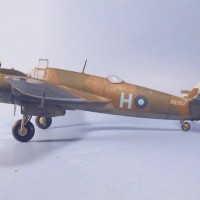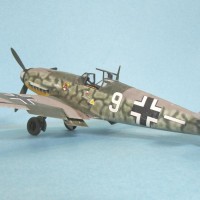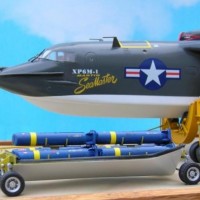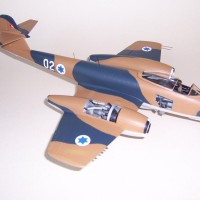Roden 1/48 He-51B-2
There is a saying in aviation design that, "if it looks right, it is right." While this is generally true, it was unfortunately not the case as regards the Heinkel He 51, which was a completely orthodox biplane of undistinguished performance, though this was primarily due to the failure of the German aircraft industry of the period to develop suitable high performance engines as was happening in Great Britain at Rolls Royce. Had the He 51 been powered by a Kestrel, like its contemporary the Hawker Fury, things might have been different, even if it was nowhere near as maneuverable as that famous classic.
What was important about the He 51 from a design standpoint was its elegance of line, being the first design to come from the aestheic of designer Walter Gunter; complemented by the mathematic genius of his twin brother Siegfried, these two would provide the indelible hallmark "look" of Heinkel aircraft of the Thirties.
The airplane first appeared as the He 51a. The Technischen Amt of the Luftfahrtkommisariat became interested when it was revealed it had a higher performance than the Arado Ar 65E which was planned as the first fighter equipment of the still secret Luftwaffe, with the same BMW 6.0 ZU engine; this fighter promised performance that would equal the international standard.
Introduced into service as the He 51A 0, the fighter equipped the DVL Reklame Staffel Mitteldeutschland, the "Central Germany Publicity Squadron," which would later become known as II/JG.132 "Richtofen" when the Luftwaffe was revealed to the rest of Europe in 1935. Early accidents were laid to deficiencies in training rather than anything intrinsic to the design.
The He 51B differed from its predecessor in having twin wire bracing of the landing gear, and the ability to carry a 50 liter drop tank beneath the fuselage. As production proliferated in 1936 37, so did the Jagdgeschwader mounted on the elegant looking fighter, with their colorful unit markings.
The beginning of the end for the He 51 came in January 1936. The Luftwaffefuhrungsstab considered that the Arado Ar 68 offered little over the Heinkel in terms of performance and questioned putting it into production. Ernst Udet, Inspector of Fighter and Dive Bomber Pilots, decided to resolve the question. Mounted in the Ar 68E, with a very experienced pilot in an He 51, Udet out climbed, out dove and out maneuvered the Heinkel fighter with ease.
Later that year, in response to requests from General Francisco Franco, Hitler decided to provide support to the Nationalists in what was developing into the Spanish Civil War. Six He 51s were sent to Spain with six German pilots to instruct Spanish pilots. Unfortunately, the airplane was a "handful" for the Spanish, who immediately wrote off two of them. The Germans entered combat unofficially and met with such success that it was decided a "volunteer" fighter squadron would be seconded to the Spanish, to allow Luftwaffe pilots to gain invaluable combat experience. At about the same time, Polikarpov I 15s flown by Soviet "volunteers" appeared on the side of the Republicans. When the two fighters met, it was no contest as to which was the better: the "Chato" could fly rings around the Heinkel, as well as outgun it, and the He 51s were reduced to targets, unfit to take part in aerial combat. The He 51 became a ground attack fighter for the remainder of its service in Spain, and was replaced in Luftwaffe service as rapidly as possible.
In retrospect, the failure of the He 51 when it entered combat was ultimately a good thing for the Luftwaffe, since it forced the service to bring the Messerschmitt Bf 109 into operational use far earlier than would otherwise have been the case, subjecting that great design to the pressure of wartime development from the beginning of its career, and assuring it of the ascendancy it would hold when war finally broke out in Europe three years later. As well, the early introduction of the Bf 109 into combat forced the pilots of the Luftwaffe to abandon the useless formations and tactics of the biplane era, and create tactics and formations appropriate to a high speed fighter; this would mean they could out fly their enemies for at least the first two years of the Second World War, since their opponents still used the outmoded tactics.
Roden's He-51 appeared in the summer of 2015 and is the first mainstream injection-molded kit of this airplane in 148 scale. Classic Airframes released two different attempts at the airplane as limited run kits back in 1996. For those who still have that kit, this kit far outshines it. Special Hobby, which did the CA kit, has re-released it as the He-51C float flghter.
The kit has beautiful restrained fabric surface detail, and a fully detailed cockpit. The cabane and interplane struts are appropriately thin. The one-piece wings are commendably thin.
The decals are the usual Roden so-so affair and are better replaced with aftermarket decals. I have found that while Aeromaster decals are long out of print, they are readily available if you look at prices that are not out of line with the price of contemporary aftermarket decals.
Assembly was a breeze, and certainly far easier than my memory of the two Classic Airframes kits I built. I prepainted the cockpit in RLM02 and then assembled it and inserted the full assembly in the fuselage and closed it up. You have a commendably-thin side flap, but I chose to close it up also to preserve the overall lines. Anyone who puts effort into extra detail in the cockpit will be happy to have that flap down.
There is no way around putting the saxophone exhausts in before further assembly. These parts had some flash and had to be thoroughly cleaned up to insure good fit.
I attached the horizontal stabilizers and then attached the separate rudder and elevators with the elevators drooped and the rudder kicked slightly to the side. I assembled the separate flaps on the lower wing up and the separate ailerons on the upper wing in the neutral postion. The landing gear fit easily and only needed a little clean up with the knife to get rid of the seam between inner ond outer parts.
COLORS & MARKINGS
I painted the white areas of the markings and then masked them off before giving the model an overall coat of black. I used Tamiya Light Blue for the RLM 65, and JN Grey for the RLM65 upper color. I then applied blotches of Tamiya Hull Red and Dark Green for the field-applied camouflage.
I used the Aeromaster sheet 48-458 “Spanish Civil War” and did the He-51B-1 flown by Dr. Heinrich Neumann, the Condor Legion's flight surgeon, mostly because I liked the saying on the fuselage, which translates as “Don't do me and I won't do you!”
I finished by washing the model to get rid of dried decal solvent and t hen applied a coat of clear flat varnish.
I used the Precision metals .33mm nickel steel rod for the rigging. I then attached the windscreen and the drop tank.
The He-51 may have been a dog, but it was a good-looking mutt, and historically belongs in any 1930s aircraft collection of significant types. The Roden kit is the best one out there other than the very pricey Silver Wings 1/32 resin kit. Eduard has released this kit with their Bf-109E-1 as a limited release Spanish Civil War set with photoetch detail and great decals. If you like this airplane, that would be well worth the price. Highly recommended for Spanish Civil War, Luftwaffe and biplane fans.












Another nice build Tom! Love these Spanish Civil War aircraft - need to build some. I've been intrigued by the He 51's lines for awhile.
Great build and history , I agree the He 51 is certainly a good looker. Not the last aircraft that suffered from an inadequate engine.
Oh how I love those twin wires you managed to string between the wings! The so called civil war in Spain had a few interesting planes and vehicles. This is one but the one I always fancy most is the Fiat CR 32, not only ugly but also mean looking. Congratulations on a really nice and unusual aircraft.
I think I may a little 'off message' with this one - the .33 rod to my eye looks a little out if scale for 1/48. Also, looks like the starboard ventral rod on the lower plane is hanging loose, but the back story as usual is interesting and the livery eye-catching.
Proof one should re-photograph after correcting a mistake. 🙂
Cheers, Tom. Taken in good spirit.
Thinking abut a theme collection, last of the fighting biplanes. This, CR-42, Gladiator, F3fs, KI-10, I-153, Avia 534.
The Eduard Legion Condor set is a deal, hereabouts. The Roden He-51 costs slightly less than the set.(!). Plus, you get photoetch for both, and a nice decal sheet, with multiple choices. And an Me-109E 1/3 (both wings) that runs $39 in the profipack, alone.
Tom,
Very nicely done and I like the scheme you chose. I think the 51 is one of the very best looking biplanes. I agree this is an excellent kit.along with many other things I have going I have one of these started. This will provide inspiration to complete it.
Very nice Tom. I still gave the Classic Airframes kit which I'll persevere with. If I didn't have it already, I'd have gone the Roden kit.
Great build, and a great review Tom. I saw,this kit at the local hobby store, had it in my hands and put her down. I guess I'm heading back there to spend money...again...thanks Tom. 😉
Seriously, I love your posts, and the historical context you add to them.
Nice job, Tom!